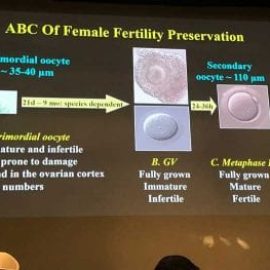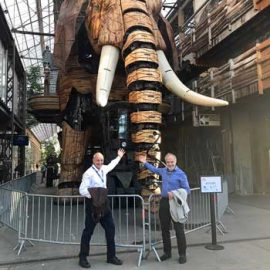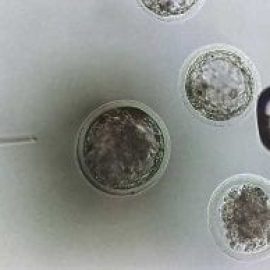Vet Times Article 'Inspirational Experience' At Animal Reproduction Event
Nantes, the fourth largest city in France, was a very fitting place for hosting the 34th Scientific Meeting of the Association of Embryo Technology in Europe (AETE).
This former port city in Brittany, 30 miles from the coast, is navigable with large vessels – evidenced by the location of the conference banquet. The exclusive event took place on the Loire river, surrounded by old war ships and other large seafaring vessels.
Navigating estuaries far from the open sea is akin to embryo transfer technologies, but at the opposite ends of the size scale. Collecting embryos or oocytes and then transferring them into a long-enclosed uterus requires an experienced captain, with a good knowledgeable crew.
The conference material was dominated with in vitro technological information and research results. Is this the way forward? If the conference was a representation of the future of embryo transfer (ET) in European countries, IVF does seem to be the way. Ovum pick-up (OPU) and IVF followed by successful ET were all discussed, debated and displayed to more than 200 delegates hungry to learn of the advancements applicable for their research and commercial productions.

Helen Picton's ABC of female Fertility preservayion.
One paper, “Good pregnancy rate of bovine biopsied vitrified IVP embryos”, presented by Erik Mullaart, described using vitrification of IVP biopsied embryos as a method of freezing them with resultant pregnancy rates good enough to use in commercial settings. They obtained 55% pregnancy results for quality 1 embryos and 44% pregnancy results for quality 2 embryos. Vitrification of bovine embryos may be back on the scene.
Two companies from Brazil announced at the conference they were introducing a technology called intra-follicular immature oocyte transfer (IFIOT). IVF is the leading embryo production technique, but IFIOT may be the future.
IFIOT is a technique that doesn’t use a laboratory, but has all of the advantages of in vitro fertilisation. It is claimed breeders can obtain mbryos with the same speediness IVF provides – that is, around one calf per week, from a single donor cow, without the embryos leaving the farm.
Helen Picton, from the Reproduction and Early Development Research Group at the University of Leeds Institute of Cardiovascular and Metabolic Medicine, was one of the eminent invited speakers, who gave an inspirational presentation. Her knowledge and experience shone through as she presented work she had been involved with in the human field.
Whole ovaries have been frozen, and successfully thawed and surgically replaced, becoming functional and productive. The best example she gave was of a young girl who, at the age of nine, developed cancer. Her ovary was removed and frozen prior to successful immunotherapy for the cancer. Her ovary was subsequently thawed and successfully replaced. At the age of 23, she gave birth to a healthy baby. This was the ultimate in personal fulfilment, but also a huge step towards developing successful ovarian auto-grafting.
In conclusion, Prof Picton said the considerable recent progress in cryobiology, reproductive science, and in vitro growth and maturation technology, have led to therapeutic advances in assisted reproductive technologies that have significantly improved our ability to cryopreserve female fertility – achievable by banking primordial oocytes in situ within ovarian tissues or by vitrification of M11 oocytes.
The stage is now set to translate these clinical advances for animal conservation and use them to develop comprehensive strategies, which will not only safeguard the future genetic diversity of commercially important domestic species, but also
facilitate germplasm preservation for animals at risk of extinction.
The bovine trend continues to be with OPU and IVF embryos, with genomic selection being the future. Genomic testing is now routinely used to select the best animals for breeding and the same method can be used to select the best embryo. However, the process of genomic selection (that is, genotyping and breeding value estimation) takes a few days, requiring the embryo to be frozen while results are obtained. Good pregnancy results are already obtained using biopsied flushed (in vivo) embryos after slow-freezing with ethylene glycol, but when using in vitro production (IVP) embryos, pregnancy rates are too low for commercial use (30%, compared to 50%).
Brazil is the first country to successfully perform full IFIOT. Embryos produced in vitro are obtained via the laboratory. In conventional IVF, the oocytes are aspirated using the ultrasound guidance when they are immature. Over seven days they are then matured and fertilised in the Petri dish, after which time they are transferred to the surrogate cow. With IFIOT, the claimed advantage is the whole process is done within the animal, the oocytes are aspirated in a similar manner to the IVF oocytes, but are then cultivated within another cow (the ovulatory). After ovulation, they are fertilised via AI, and then collected and transferred seven days later with a process similar to in vivo embryo production. The whole process occurs naturally, taking advantage of the ovulator’s physiological events, which gives the embryo more quality. They also claim the process decreases the production costs, due to there being no need for a laboratory.
The Brazilians claim IFIOT comes with fewer disadvantages of the IVF technique. However, IFIOT will not be a technique available in the UK for a long time. They need to increase efficiency and need it adopted by their production sector before others will follow.

The mechanical elephant of "Les Machines de lile".
Success
Once the embryological knowledge capacity was reached, it was time to move on to one of the largest mammals on Earth.
Nantes is the home of Les Machines de l’île (the Machines of the Isle of Nantes) – a fantasy artistic project created by François Delarozière and Pierre Orefice – a crossover dream mixing Jules Verne’s invented worlds, with the mechanical universe imagined by the genius of Leonardo da Vinci.
Two hours from Paris with the TGV (bullet train), the city of Nantes’ industrial history, where the creatures are located, landed itself well to the adventure, located on the site of a former shipyard.
The Grand Éléphant ride is a 30-minute voyage atop the magnificent animal, while it sprays around massive amounts of water. Besides the elephant’s main attraction, a vast gallery houses many other giant animals, such as an ant, a eron and a caterpillar.
Attendance at the AETE meeting is always an inspirational experience and on returning home it spurred us on to get our advanced breeding unit at Embryonics in Cheshire up and running.
Our first oocyte collection in conjunction with active ET was a great success and collections every two weeks are planned, increasing as demand inevitably comes about. We shall be adopting new techniques to aid in-house problem breeder
pedigree cows.

